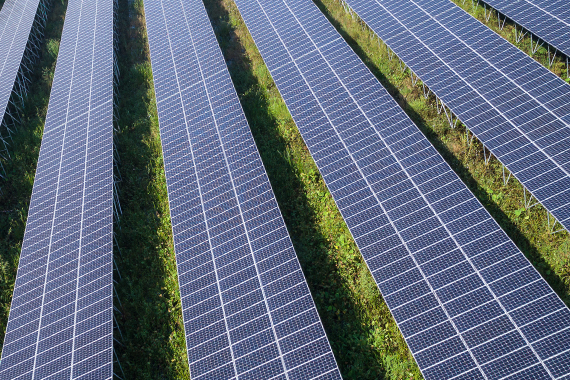
What is renewable energy finance? Let's find out so you can better understand agricultural finance.

In the world of agriculture it’s almost impossible to know what a year will hold. While one harvest might provide a bumper haul of crops, the next might fail to produce anything at all; there’s very little reliability and stability in the farming sector, even before market forces come into play. However, investing in green energy can provide farmers with a valuable way to guarantee some income from land which they may not currently use; converting a portion of an estate into a renewable energy source can be an extremely valuable way to repurpose land, and can give farms a reliable source of income.
Thanks to global environmental commitments subsidisation and investment in green technology has increased hugely in the past decade, and farmers are now able to choose from several different methods of generating benefits from their land. From anaerobic digestion to solar generation, biofuel production to wind turbines and heat pumps, farmers can now produce money from their land without planting crops or caring for animals. Installing any form of eco-friendly apparatus is inherently expensive, however, and it’s difficult for farmers to generate the capital necessary to invest in a new solar energy plant, for example. Though it may prove profitable in the long run, any new project like this requires a significant investment of cash at the start to jump-start production.
Farmers can take advantage of a unique form of loan known as “bridging finance” to cover the costs of starting a renewable energy project. These loans are high-value short-term secured loans that enable borrowers to kick-start projects with a lump sum of capital. In this article we’ll discuss the ways in which bridging loans can help solve farmer’s problems, and how they can help generate a profitable renewable energy installation. A bridging loan, like any financial product, comes with a price tag, and it’s important for anyone considering this form of loan to understand the responsibilities and implications of this type of finance. Before committing to a bridging loan, farmers should consult a specialist financial advisor to ensure this is the correct course of action in their situation.
There are many ways in which investment in renewable energy can significantly aid a farm, from reducing outgoing costs to providing a stable and secure source of secondary income. By producing energy, farmers are able to take control of their own production and either cut their costs or boost their income, and the ability to do so empowers farmers to create additional space in their bottom line.
There are a multitude of methods which farmers can use to make money from renewable energy, and one of the most straightforward ways is to invest in solar energy. This has several key advantages: solar panels are relatively quick and easy to install, with a lower level of investment per unit than a wind turbine, for instance. They are also highly efficient, and just a few panels are often enough to generate a profitable amount of electricity (or to offset the farm’s usage). Because solar panels are also fairly small and easily installed, they can also be placed on land which can’t easily be used for planting crops or raising animals; this allows farmers to utilise land that is otherwise lying fallow to make a profit.
Biofuel production is a new and interesting alternate energy source that has grown more popular in recent times, and which provides a highly flexible source of fuel for farms (especially pastoral farms). Because a biofuel plant allows farmers to turn manure into fuel for the farm’s equipment, they can cut down on fuel costs while also monetising a byproduct of their existing livestock. Whilst many pastoral farmers have traditionally used the manure from their livestock as a source of income by selling it off as fertiliser, they can instead use a portion of it to create fuel. Biofuel doesn’t degrade, is easily stored, and may be used all year round, unlike manure, so this can be a very valuable option for farmers with lots of animals.
Farmers also stand to benefit from green investments that help them cut down on their own energy requirements. Air and ground source heat pumps allow farmers to harness free thermal sources to heat their premises, which makes keeping herds warm in winter a much easier task.
When investing in renewable energy it’s important for farmers to understand precisely how a bridging loan works. At its most basic, a bridging loan is a high value short-term loan that is secured against the assets of the borrower, much in the way that a mortgage is secured against the borrower’s property. Because it is secured, bridging loans can be offered for larger purchases than typical personal and business loan. Where bridging loans really shine is in the combination of the size and security of a mortgage with the speed and flexibility of personal lending.
Bridging loans can be put into place in just a matter of days, which allows farmers to quickly and easily choose where to make investments. Being able to complete a purchase quickly allows borrowers to take advantage of opportunities as they arise, instead of having to operate within the constraints of their cash flow. This means that borrowers can take out loans when it suits them, and they are also able to make use of the unparallelled flexibility of bridging lenders when establishing a payment structure. Even more so than most businesses, farms need to keep running costs down during the year, as until the harvest is brought in, there’s little income being produced (unless, of course, they’re selling renewable energy back to the National Grid). Many bridging providers will allow their customers to “roll up” interest until the end of the loan, which means that there are no ongoing costs. Although this is typically more expensive in the long run, it does make bridging loans easier to finance for farmers, and a well-judged loan for green energy projects can make all the difference to a farm’s prospects.
A bridging loan is a short-term loan secured against property. It allows you or your business to “bridge a gap” until either longer-term finance can be arranged, or the underlying security or other assets can be sold.
Commercial bridging loans are, as their name implies, bridging loans that are secured against commercial property.
There are many ways in which businesses can use a commercial bridging loan. Common uses are to cover short-term cashflow issues or to finance tax liabilities. More positively they can be used as working capital and by new businesses as a cashflow injection to acquire additional stock or even to acquire new equipment or premises for the business. Beyond these examples there are a huge variety of ways in which commercial bridging loans can be used.
Yes they can. They can be used by a huge variety of companies and by foreign nationals who can struggle to get High Street Finance.